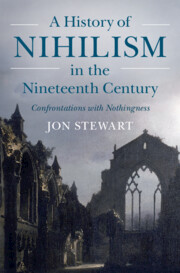Book contents
- A History of Nihilism in the Nineteenth Century
- A History of Nihilism in the Nineteenth Century
- Copyright page
- Dedication
- Contents
- Figures
- Preface
- Acknowledgments
- Introduction
- 1 Jean Paul’s Vision of Nihilism and Plea for the Doctrine of Immortality
- 2 Klingemann and the Absurdity of Nothingness in The Nightwatches
- 3 Nihilism in English Romanticism
- 4 Schopenhauer’s Theory of Human Suffering and Lack of Meaning
- 5 Büchner’s Account of the Reign of Terror as a Mirror of Human Existence
- 6 Poul Martin Møller’s Criticism of Hegelianism and the Danish Discussion of Nihilism
- 7 Kierkegaard and the Indefinability and Inexplicability of Death
- 8 Turgenev’s Portrait of a Nihilist
- 9 Nietzsche’s Vision of the Past and the Future of Nihilism
- 10 The Importance of Nihilism in the Nineteenth Century
- Selected Bibliography on Nihilism
- Name Index
- Subject Index
3 - Nihilism in English Romanticism
Byron and Shelley
Published online by Cambridge University Press: 10 March 2023
- A History of Nihilism in the Nineteenth Century
- A History of Nihilism in the Nineteenth Century
- Copyright page
- Dedication
- Contents
- Figures
- Preface
- Acknowledgments
- Introduction
- 1 Jean Paul’s Vision of Nihilism and Plea for the Doctrine of Immortality
- 2 Klingemann and the Absurdity of Nothingness in The Nightwatches
- 3 Nihilism in English Romanticism
- 4 Schopenhauer’s Theory of Human Suffering and Lack of Meaning
- 5 Büchner’s Account of the Reign of Terror as a Mirror of Human Existence
- 6 Poul Martin Møller’s Criticism of Hegelianism and the Danish Discussion of Nihilism
- 7 Kierkegaard and the Indefinability and Inexplicability of Death
- 8 Turgenev’s Portrait of a Nihilist
- 9 Nietzsche’s Vision of the Past and the Future of Nihilism
- 10 The Importance of Nihilism in the Nineteenth Century
- Selected Bibliography on Nihilism
- Name Index
- Subject Index
Summary
Chapter 3 represents a brief foray into the broad topic of nihilism in English Romanticism. It begins with a close reading of Lord Byron’s poem Manfred, which tells the story of a man who is tormented by knowledge and in a sense dies as a result of it. Manfred is a kind of Faustian figure zealous for learning. He pursues his occult studies alone in a tower in the Alps. Over time he attains powers of magic that allow him to evoke supernatural spirits. Manfred is haunted by a memory in the past that leaves him no rest. This is read as an autobiographical reference to Byron’s incestuous relations with his half-sister, Augusta Leigh, which resulted in such a scandal that he felt obliged to leave England forever. Manfred seeks in vain for help from the different spirits of nature, who are unable to oblige him in his request to make him forget his past completely. Manfred heroically rejects that even the most powerful spirit can stand in the way of his freedom, and he insists on dying on his own terms. The chapter concludes with a brief analysis of Shelley’s famous poem “Ozymandias,” which is read as a call for self-reflection on the fleetingness of our existence and all human accomplishment.
Keywords
- Type
- Chapter
- Information
- A History of Nihilism in the Nineteenth CenturyConfrontations with Nothingness, pp. 99 - 125Publisher: Cambridge University PressPrint publication year: 2023

